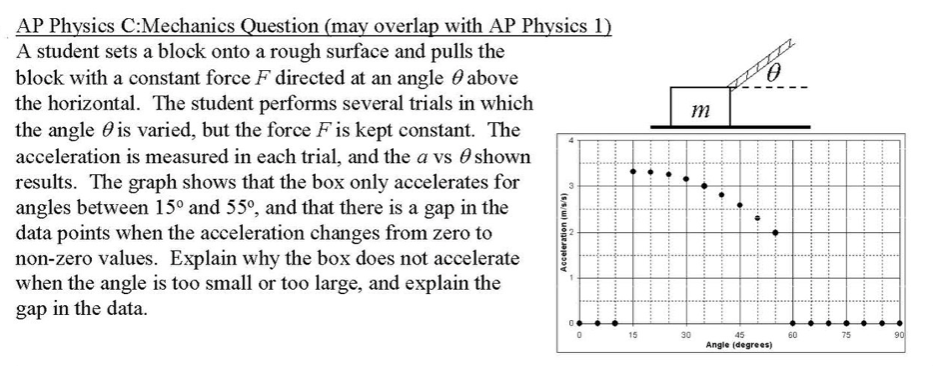A student sets a block onto a rough surface and pulls the block with a constant force F directed at an angle 0 above the horizontal. The student performs several trials in which the angle O is varied, but the force F is kept constant. The acceleration is measured in each trial, and the a vs 0 shown results. The graph shows that the box only accelerates for angles between 15° and 55°, and that there is a gap in the data points when the acceleration changes from zero to non-zero values. Explain why the box does not accelerate when the angle is too small or too large, and explain the gap in the data.
A student sets a block onto a rough surface and pulls the block with a constant force F directed at an angle 0 above the horizontal. The student performs several trials in which the angle O is varied, but the force F is kept constant. The acceleration is measured in each trial, and the a vs 0 shown results. The graph shows that the box only accelerates for angles between 15° and 55°, and that there is a gap in the data points when the acceleration changes from zero to non-zero values. Explain why the box does not accelerate when the angle is too small or too large, and explain the gap in the data.
Related questions
Question

Transcribed Image Text:A student sets a block onto a rough surface and pulls the
block with a constant force F directed at an angle 0 above
the horizontal. The student performs several trials in which
the angle O is varied, but the force F is kept constant. The
acceleration is measured in each trial, and the a vs 0 shown
results. The graph shows that the box only accelerates for
angles between 15° and 55°, and that there is a gap in the
data points when the acceleration changes from zero to
non-zero values. Explain why the box does not accelerate
when the angle is too small or too large, and explain the
gap in the data.
Expert Solution
This question has been solved!
Explore an expertly crafted, step-by-step solution for a thorough understanding of key concepts.
This is a popular solution!
Trending now
This is a popular solution!
Step by step
Solved in 3 steps with 3 images
